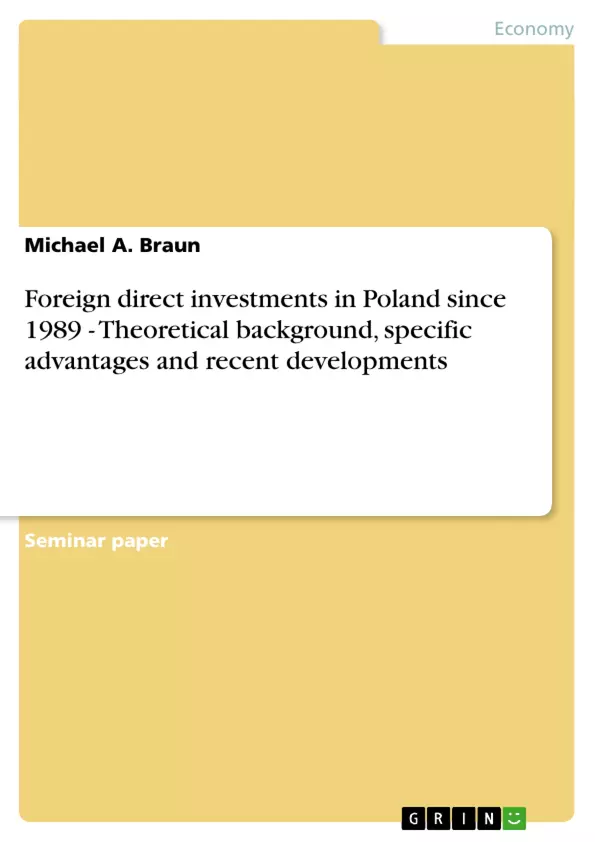The collapse of communism has started a dramatic change in the economies and societies of eastern and central Europe (ECE). The transformation from a planned to a market-economic system has lead to the opening of previously closed markets. Since 1989 this region is not only a new market to sell to, but also a place to produce. And especially western-European enterprises might benefit from this due to short distances, which help to integrate these locations into a worldwide firm-strategy.
European companies now have got the same possibilities like the US or even Japan to produce cheaper directly at their doorstep. However, the integration of ECE does not simply mean the extension of western markets to an eastern location. There is much more such as the complete restructuring of western production chains. Or in other words, there is a dual process of transformation (east) and structural change (west).
This report focuses on Poland and its foreign direct investment (FDI) inflows since 1989. In order to evaluate the importance of FDI for Poland, three guideline questions are asked: (1) Why do companies invest in general in foreign areas? (2) Why received this specific country capital from international investors? And (3) finally, to what extent and in which sectors have foreign investors invested? Therefore, a core model in economics was used to solve these questions: the concept of ownership-, location- and internalisation-specific advantages.
One does not know what future might bring. But for sure Poland has tried to find its position within a new world order. After centuries of dependence, this county now seems to be willing to search for a bright future. Therefore FDI are seen to help to stabilize and to develop that country. And even the short period of time since 1989 might underline this, too.
Inhaltsverzeichnis (Table of Contents)
- Introduction and academic method
- Theoretical background
- Foreign direct investments
- Paradigm of ownership, location and internalisation
- Traditional theories of foreign direct investments
- Capital arbitrage theory
- Modern theories of foreign direct investments
- Product-cycle model
- Hymerian view
- Internalisation theories
- Eclectic theory
- Political risk
- Types of political risk
- Obsolescing bargain model
- Conclusion of the theoretical part
- Foreign direct investment location Poland
- Economic status
- Reasons for foreign direct investments in Poland
- General method to asses a location
- Application of the OLI on Poland
- Flows of foreign direct investments into Poland
- Effects of foreign direct investments
- On the source country
- On the host country
- Conclusion
Zielsetzung und Themenschwerpunkte (Objectives and Key Themes)
This report aims to examine the reasons behind foreign direct investments (FDI) in Poland since 1989, focusing specifically on the motivations of companies to invest in this region and the impact of these investments. It seeks to understand the economic, political, and theoretical factors influencing FDI inflows into Poland, exploring the role of the OLI paradigm, the obsolescing bargain model, and other relevant economic theories.
- The theoretical framework of foreign direct investments
- The specific advantages of Poland as a location for FDI
- The analysis of FDI flows and their effects on Poland
- The role of political risk in FDI decisions
- The impact of FDI on both the source and host countries
Zusammenfassung der Kapitel (Chapter Summaries)
The first chapter of this report introduces the topic of FDI in Poland and the specific research questions that will be addressed. It outlines the academic method used in the report, which includes reviewing current literature and applying generally used economic theories.
The second chapter focuses on the theoretical background of FDI and political risk. It delves into traditional and modern theories of FDI, examining these theories from a company's perspective. The widely used concept of the OLI (Ownership, Location, and Internalization) paradigm is applied to the report's analysis. Furthermore, the chapter explores the influence of political risk through the lens of the Obsolescing Bargaining Model.
The third chapter connects the theoretical concepts discussed in the previous chapter with the specific case of FDI in Poland. It examines the economic status of Poland, the specific reasons for foreign investors to choose Poland as a location, and the overall situation of FDI inflows in the country. The chapter also provides figures on Polish FDI inflows since 1989 and briefly discusses the benefits of FDI for the host country.
Schlüsselwörter (Keywords)
This report focuses on the theoretical and practical aspects of foreign direct investment (FDI) in Poland, particularly since the collapse of communism in 1989. The key terms and concepts include: Ownership, Location, and Internalization (OLI) paradigm, Obsolescing Bargaining Model, FDI flows, political risk, economic status, and the specific advantages of Poland as a location for FDI.
- Citar trabajo
- Michael A. Braun (Autor), 2003, Foreign direct investments in Poland since 1989 - Theoretical background, specific advantages and recent developments, Múnich, GRIN Verlag, https://www.grin.com/document/69566



